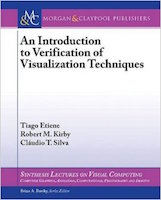New Book on Verification of Visualization Techniques
 An Introduction to Verification of Visualization Techniques
An Introduction to Verification of Visualization Techniques
By Claudio T. Silva (along with Tiago Etiene of Modelo Inc. and Robert M. Kirby of the University of Utah)
Morgan & Claypool Publishers 2015
As we increase our reliance on computer-generated information, often using it as part of our decision-making process, we must devise tools to assess the correctness of that information. Consider, for example, software embedded on vehicles, used for simulating aircraft performance, or used in medical imaging. In those cases, software correctness is of paramount importance as there's little room for error. Software verification is one of the tools available to attain such goals. Verification is a well-known and widely studied subfield of computer science and computational science and the goal is to help us increase confidence in the software implementation by verifying that the software does what it is supposed to do.
The goal of this book is to introduce the reader to software verification in the context of visualization. In the same way we became more dependent on commercial software, we have also increased our reliance on visualization software. The reason is simple: visualization is the lens through which users can understand complex data, and as such it must be verified. The explosion in our ability to amass data requires tools not only to store and analyze data, but also to visualize it.
This book is comprised of six chapters. After an introduction to the goals of the book, the authors present a brief description of both worlds of visualization (Chapter 2) and verification (Chapter 3). They then proceed to illustrate the main steps of the verification pipeline for visualization algorithms. They focus on two classic volume visualization techniques, namely, Isosurface Extraction (Chapter 4) and Direct Volume Rendering (Chapter 5). They explain how to verify implementations of those techniques and report the latest results in the field of verification of visualization techniques. The last chapter concludes the book and highlights new research topics for the future.
Claudio T. Silva is a professor of computer science and engineering and data science at New York University’s Tandon School of Engineering. His research lies at the intersection of visualization, graphics, data analysis, and geometric computing, and recently he has been interested in urban data and sports analytics.
Silva has published over 220 journal and conference papers, and he is an inventor of 12 U.S. patents. He received a B.S. in mathematics from the Federal University of Ceara (Brazil) in 1990, and a Ph.D. in computer science from State University of New York at Stony Brook in 1996. He has held positions in academia and industry, including at AT&T, IBM, Lawrence Livermore, Sandia, and the University of Utah. He is an active member of the research community, has participated in more than 100 international program committees, and has served on the editorial boards of multiple journals, including the IEEE Transactions on Visualization and Computer Graphics, ACM Transactions on Spatial Algorithms and Systems, and IEEE Transactions on Big Data. Additionally, he has served as general and papers co-chair of a number of conferences, including the IEEE Visualization.
Silva's work has received a number of major awards. In 2013, he was elected an IEEE fellow, and in 2014 he won the IEEE Visualization Technical Achievement Award. He helped develop MLB.com's Statcast player tracking system, which won the Alpha Award for Best Analytics Innovation/Technology at the 2015 MIT Sloan Sports Analytics Conference. That year he was also elected Chair of the IEEE Technical Committee on Visualization and Computer Graphics.




